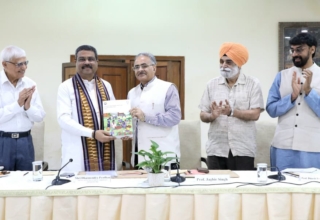
The 2nd edition of national rankings by the union ministry of Human Resource Development under the National Institutional Ranking Framework (NIRF) released on April 3 displays supremacy of public (Govt ) HEIs. The first ever degree colleges ranking is dominated by southern states though six DU colleges figure in top 10 see 100 ranks on (https://www.nirfindia.org/ranking2017.html)
A total of 2995 institutions have participated this time. This includes 232 Universities, 1024 Engineering Institutions, 546 Management Institutions, 318 Pharmacy Institutions and 637 General Degree Colleges, and others. Many of these have participated in multiple disciplines, adding to a total of 3319 participants across disciplines. “India Rankings 2017” have ranked institutions in the disciplines/categories– Universities, Engineering Institutions, Management Institutions, Pharmacy Institutions and General Degree Colleges. It also provides a common overall rank across all disciplines for those institutes which either have more than 1000 enrolled students, or which are centrally funded.
List of top 10 India Rankings 2017
Overall:
- Indian Institute of Science, Banglore, Karnataka
- Indian Institute of Technology, Madras (Chennai), Tamil Nadu
- Indian Institute of Technology, Bombay (Mumbai), Maharashtra
- Indian Institute of Technology, Kharagpur, West Bengal
- Indian Institute of Technology, New Delhi, Delhi
- Jawahar Lal Nehru University, New Delhi, Delhi
- Indian Institute of Technology, Kanpur, Uttar Pradesh
- Indian Institute of Technology, Guwahati, Assam
- Indian Institute of Technology, Roorkee, Uttarakhand
- Banaras Hindu University, Varanasi, Uttar Pradesh
Engineering
1. Indian Institute of Technology, Madras, Tamil Nadu
2. Indian Institute of Technology, Bombay (Mumbai), Maharashtra
3. Indian Institute of Technology, Kharagpur, West Bengal
4. Indian Institute of Tchnology, New Delhi, Delhi
5. Indian Institute of Technology, Kanpur, Uttar Pradesh
6. Indian Institute of Technology, Roorkee, Uttarakhand
7. Indian Institute of Technology, Guwahati, Assam
8. Anna University, Chennai, Tamil Nadu
9. Jadavpur University, Kolkata, West Bengal
10. Indian Institute of Technology, Hyderabad, Telangana
Management
1.Indian Institute of Management, Ahmedabad, Gujarat
2. Indian Institute of Management, Banglore, Karnataka
3.Indian Institute of Management, Calcutta, West Bengal
4. Indian Instituut of Management, Lucknow, Uttar Pradesh
5.Indian Institute of Management, Kozhikode, Kerala
6. Indian Institute of Technology,New Delhi, Delhi
7. Indian Institute of Technology, Kharagpur, West Bengal
8. Indian Institute of Technology, Roorkee, Uttarakhand
9. Xavior Labour Relations Institute (XLRI), Jamshedpur, Jharkhand
10. Indian Institute of Management, Indore, Madhya Pradesh
University
1.Indian Institute of Science, Banglore, Karnataka
2. Jawaharlal Nehru University, New Delhi, Delhi
3. Banaras Hindu University
4. Jawaharlal Nehru Centre for Advanced Scientific Research, Banglore, Karnataka
5.Jadavpur University, Kolkata, West Bengal
6. Anna University, Chennai, Tamil Nadu
7. University of Hyderabad, Hyderabad, Telangana
8. University of Delhi, Delhi
9. Amrita Vishwa Peetham, Coimbatore, Tamil Nadu
10. Savitribai Phule PuneUniversity, Pune, Maharshtra
Colleges
1. Miranda House, Delhi, Delhi
2. Loyola College, District Chennai, Tamil Nadu
3. Shri Ram College of Commerce, New Delhi, Delhi
4. Bishop Heber College, District Tiruchirapalli, Tamil Nadu
5. Atma Ram Sanatan Dharma College,New Delhi, Delhi
6. St. Xavier’s College, Kolkata, West Bengal
7. Lady Shri Ram College for Women,New Delhi, Delhi
8. Dyal Singh College, Delhi, Delhi
9. Deen Dayal Upadhyay College, New Delhi, Delhi
10. The Women’s Christian College, Chennai, Tamil Nadu
Pharmacy
1. Jamia Hamdard, New Delhi, Delhi
2. National Institute of Pharmaceutical Education and Research, Mohali, S.A.S. Nagar (Mohali), Punjab
3. University Institute of Pharmaceutical Sciences, Chandigarh, Chandigarh
4. Indian Institute of Chemical Technology, Mumbai, Maharashtra
5. National Institute of Pharmaceutical Education and Research, Hyderabad, Telangana
6. Birla Institute of Science, Pilani, Rajasthan
7. Manipal College of Pharmaceutical Science, Manipal, Karnataka
8. Poona College of Pharmacy Erandwane Pune, Maharashtra
9. S.R.M.Institute of Science and Technology, Chennai, Tamil Nadu
10. JSS College of Pharmacy, Mysore, Karnataka
While releasing the rankings in New Delhi, union HRD minister Prakash Javadekar said this ranking is meant to have beginning of a fair competition among the institutions for achieving excellence in their efforts. This has recorded success beyond any doubt and is bound to march ahead. The Minister on this occasion also announced that government will extend more help to quality education institutions. It’s a vital change of policy and will motivate all the institutions to perform and excel. Factors regarding number of research papers submitted, patents obtained and campus placement figures will also count for seeking government support. He said importance to public perception, employer perception and academic perception will also be accorded.
The parameters used for India Rankings 2017 are broadly similar to those used last year. However, at the level of detail, some of the sub-parameters have been tweaked for a more robust system of rankings. In particular for evaluating Research Impact, parameters for quality of publications have been enhanced to include the number of highly cited papers, in addition to the usual parameters of publications per faculty and citations per paper. Innovations have also been made in improving the scoring metrics, where the “percentile” metric has been replaced by a more discriminating metric. All research related information, including publications, citations, highly cited papers and even patent information about institutes was collected from third party databases (from our industry partners) to obtain an objective and unbiased picture. For this year’s Perception inputs, a large data base of academic and industry peers and employers was deployed, in addition to getting inputs from members of general public. Finally, some provision has also been made for the scale of operations of an institute in terms of the size of its student population and graduated doctoral students.
According to K K Sharma, secretary higher education, the data received from both institutional and third party sources were subject to extensive scrutiny for consistency and correctness by a team of experts. As per the declared time-schedule, the rankings are being announced on the first Monday of April. The Rankings List includes 100 institutions each in the Overall, University, Engineering and General College Categories, and 50 each in Management and Pharmacy Disciplines. Additional rankings in suitably bunched forms are also being provided.
Although the Central Government funded institutions, in general continue to do well, some of the state-funded universities also are prominent. Some private institutions and universities have also been quietly climbing up to take high positions, thus offering value for money to their students, going by their ranks. Some of these institutions have consistently maintained or improved their positions of last year, clearly indicating that it was not a one-time fluke event. This is clearly a satisfying development in Higher Education.
Finally, a very exciting feature of this year’s Rankings is the ranking of General Degree Colleges in Arts and Sciences from across the country. While many of the names appearing in the top-100 list are well known and famous, there are many others who may not be so well known but have fared well. Clearly these need to be watched out for in future. “There are also a few notable absentees here as also in other categories, due to their non-participation. We hope that there will be more enthusiastic participation in the years to come”, Sharma added.











